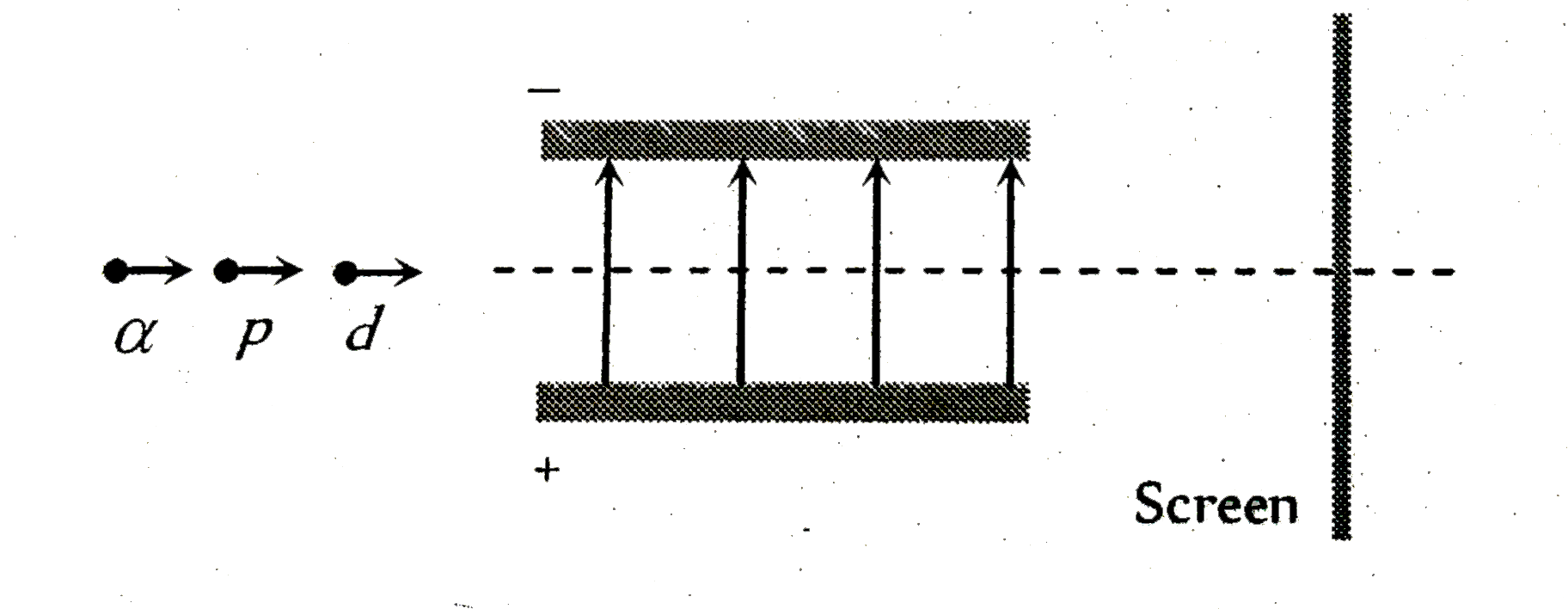Deutron and allpha- particle are put 1Å apart in air. Magnitude of intensity of electric field due to deutron at α−particle is
Zero
2.88×1011 newton / coulomb
1.44×1011 newton / coulomb
5.76×1011 newton / coulomb
To find the magnitude of the electric field intensity due to a deuteron at the position of an alpha particle, we can follow these steps:
1. Identify the Charges:
- The charge of a deuteron (D) is equal to the charge of a proton, which is +e or +1.6×10−19C.
- An alpha particle (α) consists of 2 protons and 2 neutrons, so its charge is +2e or +3.2×10−19C.
2. Determine the Distance:
- The distance between the deuteron and the alpha particle is given as 1Å=1×10−10m.
3. Use the Formula for Electric Field:
- The electric field E due to a point charge is given by the formula:
E=k⋅Qr2
where:
- k is Coulomb's constant, k=9×109N m2/C2,
- Q is the charge producing the electric field (in this case, the charge of the deuteron),
- r is the distance from the charge to the point where the electric field is being calculated.
4. Substitute the Values:
- Here, Q=+e=1.6×10−19C and r=1×10−10m.
- Substitute these values into the formula:
E=(9×109)⋅(1.6×10−19)(1×10−10)2
5. Calculate the Electric Field:
- First, calculate (1×10−10)2=1×10−20.
- Now substitute this back into the equation:
E=(9×109)⋅(1.6×10−19)1×10−20
- This simplifies to:
E=(9×109)⋅(1.6×101)=14.4×109N/C=1.44×1010N/C
6. Final Result:
- The magnitude of the electric field intensity due to the deuteron at the position of the alpha particle is:
E=1.44×1010N/C
- The charge of a deuteron (D) is equal to the charge of a proton, which is +e or +1.6×10−19C.
- An alpha particle (α) consists of 2 protons and 2 neutrons, so its charge is +2e or +3.2×10−19C.
- The distance between the deuteron and the alpha particle is given as 1Å=1×10−10m.
- The electric field E due to a point charge is given by the formula:
E=k⋅Qr2
where:
- k is Coulomb's constant, k=9×109N m2/C2,
- Q is the charge producing the electric field (in this case, the charge of the deuteron),
- r is the distance from the charge to the point where the electric field is being calculated.
- Here, Q=+e=1.6×10−19C and r=1×10−10m.
- Substitute these values into the formula:
E=(9×109)⋅(1.6×10−19)(1×10−10)2
- First, calculate (1×10−10)2=1×10−20.
- Now substitute this back into the equation:
E=(9×109)⋅(1.6×10−19)1×10−20
- This simplifies to:
E=(9×109)⋅(1.6×101)=14.4×109N/C=1.44×1010N/C
- The magnitude of the electric field intensity due to the deuteron at the position of the alpha particle is:
E=1.44×1010N/C
Topper's Solved these Questions
- BOOK - ERRORLESS CHAPTER - ELECTROSTATICS EXERCISE - Ordinary Thinking Objective Questions (Electric Dipole)38videos
ELECTROSTATICS
- BOOK - ERRORLESS CHAPTER - ELECTROSTATICS EXERCISE - Ordinary Thinking Objective Questions (Electric Flux and Gauss.s Law)28videos
ELECTROSTATICS
- BOOK - ERRORLESS CHAPTER - ELECTROSTATICS EXERCISE - Ordinary Thinking Objective Questions (Electric Flux and Gauss.s Law)28videos
ELECTROSTATICS
- BOOK - ERRORLESS CHAPTER - ELECTRONICSEXERCISE - Selv Evaluation Test23videos
ELECTRONICS
- BOOK - ERRORLESS CHAPTER - HEATING AND CHEMICAL EFFECT OF CURRENTEXERCISE - Self Evaluation Test14videos
HEATING AND CHEMICAL EFFECT OF CURRENT
Similar Questions
Knowledge Check
- Question 1 - Select One
α particles are scattered due to
Aattraction of electronsBrepulsion by the nucleusCboth 1 and 2Dgravitational pull of neutrons - Question 2 - Select One or More
A charged particle moving in an electric field
Amust undergo change in velocityBmust undergo change in speedCmay not undergo change in velocityDmay not undergo change in speed - Question 3 - Select One
A charged particle is free to move in an electric field
AIt will always move perpendicular to the line of forceBIt will always move along the line of force in the direction of the field.CIt will always move along the line of force opposite to the direction of the field.DIt will always move along the line of force in the direction of the field or opposite to the direction of the field depending on the nature of the charge
(a) A deutron and an α-particle are placed in uniform electric field. Find the ratio of their accelerations.
(b) A charged particle (q,m) is placed in uniform electric field E. Find its kinetic energy after time t.
(c ) An electron (−e,m) is given velocity v0 along a uniform electric field E. After how much time , electron will return to its original position ?View SolutionIn the previous problem what will be the frequency of electric field if the charge particle is α-particle?
View SolutionAssertion (A):β− particles are deflected more than α− particles in a given electric field.
Reason (R):Charge on α− particles is larger than on β−particles.View SolutionA protn and an alpha particle enter into a uniform magnetic field with the same velocity. The period of rotation of the alpha particle will be
View SolutionA proton, a deutron and an α-particle having the same momentum, enters a region of uniform electric field between the parallel plates of a capacitor. The electric field is perpendicular to the initial path of the particles. Then the ratio of deflections suffered by them is
 View Solution
View Solution

